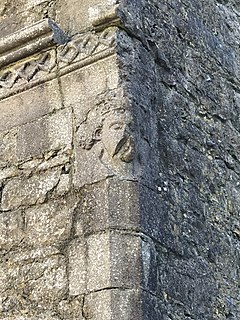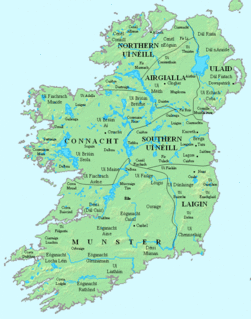| |||||
| Centuries: | |||||
|---|---|---|---|---|---|
| Decades: | |||||
| See also: | Other events of 1316 List of years in Ireland | ||||
Events from the year 1316 in Ireland.
| |||||
| Centuries: | |||||
|---|---|---|---|---|---|
| Decades: | |||||
| See also: | Other events of 1316 List of years in Ireland | ||||
Events from the year 1316 in Ireland.
| | This section is empty. You can help by adding to it. (July 2010) |
| | This section is empty. You can help by adding to it. (July 2010) |

Connacht, or Connaught, is one of the provinces of Ireland, in the west of Ireland. Until the ninth century it consisted of several independent major Gaelic kingdoms.
Tadhg, also spelled Tadgh or Tadg, is an Irish and Scottish Gaelic masculine name that was very common when the Goidelic languages predominated, to the extent that it is a synecdoche for Irish-speaking man. The name signifies "poet" or "philosopher". This was also the name of many Gaelic Irish kings from the 10th to the 16th centuries, particularly in Connacht and Munster. Tadhg is most common in south-west Ireland, particularly in County Cork and County Kerry. The name has enjoyed a surge in popularity recently; in 2005 it was the 69th most common name for baby boys and in 2010 the 40th, according to the Central Statistics Office in Ireland.
The Second Battle of Athenry took place at Athenry in Ireland on 10 August 1316 during the Bruce campaign in Ireland.

Cathal Crobhdearg Ua Conchobair (1153–1224), was a king of Connacht. He was the youngest son of the High King of Ireland Tairrdelbach Ua Conchobair and brother to the last fully recognized High King Ruadri Ua Conchobair. His own sons Aedh Ua Conchobair and Feidhlimidh Ua Conchobair were kings of Connacht after him.
Felim McHugh O'Connor was king of Connacht in Ireland from January 1310 to 10 August 1316. The beginning of his kingship saw a revival in the ancient form of inauguration performed for the Kings of Connacht after a period of apparent lapse in the practice. His reign took place against the background of a Gaelic recovery following the Anglo-Norman invasion and the disputed High Kingship of Edwurd Bruce. He was the last King of Connacht to truly hold power over the entire province and his death halted the gains that had been made following the Anglo Norman invasion, by his kingdom. His foster father Maelruanid Mac Diarmata King of Magh Lurg would play an instrumental role in his reign.
Rory na-bhFeadh mac Donough Ua Conchobair, King of Connacht 1316–1317.
Toirdelbach Ó Conchobair, anglicised Turlough O'Conor, was one of a number of claimants to the kingship of Connacht in the disastrous aftermath of the Second Battle of Athenry. He overthrew Rory na BhFeadh but was himself overthrown in 1318.
Brian Luighneach Ua Conchobhair was a Prince of Connacht.

The O'Conor family are an Irish noble house and were one of the most influential and distinguished royal houses in Ireland. The O'Conor family held the throne of the Kingdom of Connacht up until 1475. Having ruled it on and off since 967, they ruled continuously from 1102 to 1475. Moreover, the O'Conor parent house the Uí Briúin and Síol Muireadaigh ruled Connacht on many occasions - but not continuously - between 482 and 956. The house of O'Conor also produced two High Kings of Ireland, Tairrdelbach Ua Conchobair and his son Ruaidrí Ua Conchobair, the last High King of Ireland. The family seat is Clonalis House outside Castlerea in County Roscommon.
Events from the year 1106 in Ireland.
Events from the year 1156 in Ireland.
Events from the year 1258 in Ireland.
Toirdelbach is a masculine Irish given name. Forms of the name include Toirdhealbhach, Tárlach, and Traolach. An Anglicised form is Turlough. The names are ultimately derived from the Irish toirdhealbh meaning "prompting", and originated as a byname meaning "instigator".
Cathal or Cahal is a common given name in Ireland, spelled the same in both the Irish and English languages. The name is derived from two Celtic elements: the first, cath, means "battle"; the second element, val, means "rule". There is no feminine form of Cathal. The Gaelic name has several Anglicised forms, such as Cathel, Cahal, Cahill and Kathel. It has also been Anglicised as Charles, although this name is of an entirely different origin as it is derived from a Germanic element, karl, meaning "free man".
Felim O'Connor may refer to the following individuals:
Ruaidrí Ua Conchobair, called Ruaidrí na Saide Buide was King of Connacht, perhaps twice.

Uí Díarmata was a local kingdom located in what is now north County Galway.
The Clan Murtagh O'Conor were descendants of Irish High-King Toirdelbach Ua Conchobair, through his son, Murtogh Moynagh O'Conor (d.1210), tánaiste of Connacht. They have been defined by Katherine Simms as:
... the earliest, most aristocratic and best documented example of increasing nomadism in the northern half of Ireland in the late middle ages. ... In spite of the fact that they were a very numerous branch of the O'Conor family, who supplied five kings to the throne of Connacht, they seem to have vanished away in the early fifteenth century, never to be heard of again.

The Kingdom of West Breifne or Breifne O'Rourke was a historic kingdom of Ireland that existed from 1256 to 1605, located in the area that is now County Leitrim. It took its present boundaries in 1583 when West Breifne was shired and renamed Leitrim, after the village of Leitrim, which was an O'Rourke stronghold. The kingdom came into existence after a battle between the ruling O'Rourke clan and the ascendant O'Reillys caused the breakup of the older Kingdom of Breifne and led to the formation of East Breifne and West Breifne. The kingdom was ruled by the O'Rourke clan and lasted until the early 17th century, when their lands were confiscated by England.
Feilim is an Irish language name for men, which means "beauty, ever good, constant." The name is derived from the older version Feidlimid, it has been anglicised as Phelim, Feilmy or even Felix.